Some of the rarest types of caterpillars are purple. This is a color associated with a potentially-venomous species, but purple caterpillars aren’t venomous.
Plants, trees, and even legumes are the hosts of different types of purple caterpillars.
These types of caterpillars can be bright purple, dark purple, or patterned.
Most importantly, caterpillars may only be purple for a brief period in their life cycle, which means there’s typically a short window to spot these colorful caterpillars.
Some of the best places to find them include woodlands, especially oak woodlands as they feed on the large leaves of various oaks.
Parsley, poison ivy, asters, and different other types of aromatic herbs of wildflowers are also hosts to these caterpillars.
Especially common in North America, Europe, and Central America, purple caterpillars represent moth, butterfly, and even sawfly species.
The following types of caterpillars are at least partly purple with some of them being entirely purple and standing out on the leaves they live and feed on.
Table of Contents
1. Marbled Clover Caterpillar
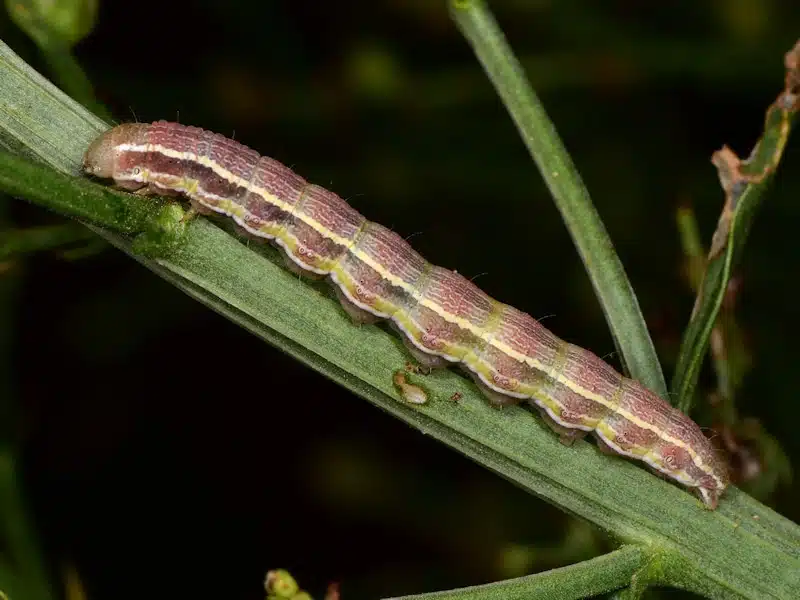
Common Toadflax and Bladder Campion are among the typical host of this purple caterpillar.
Also found on different other types of wildflowers, Marbled Clover Caterpillar (Heliothis viriplaca) goes through a purple stage.
This is an early instar stage where large purple bands are only contrasted by interfering green sections.
White stripes are also seen on the sides of the species at this stage.
As it grows, The Marbled Clover Caterpillar becomes green-dominant.
Mostly purple as a young caterpillar, this is also a species that may show purple spots on the wings of the adults.
It can be found in different types of grassy fields, especially those in areas with plenty of rainfall, with rare sights on plants that grow on the beach.
Marbled Clover Caterpillars can be found in countries such as The United Kingdom and Ireland.
2. Tobacco Budworm
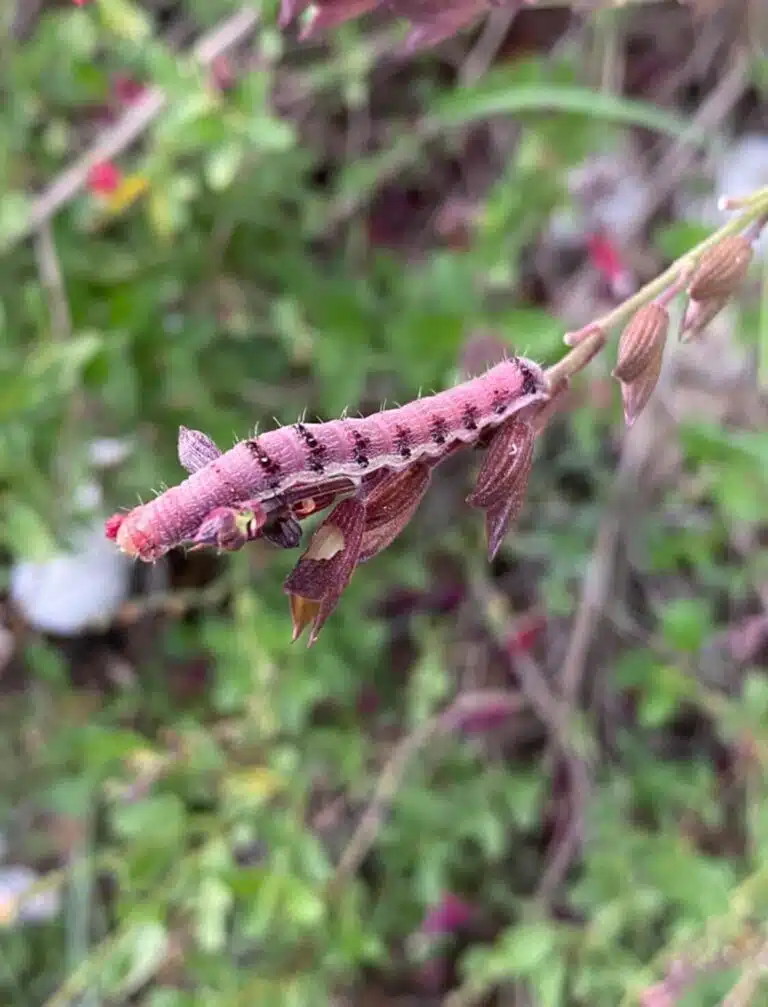
Known as a major pest in the Eastern parts of North America, Tobacco Budworms (Chloridea virescens) are some of the worst pest caterpillars as they eat multiple types of host plants.
They may also come in a purple nuance, but this isn’t a must.
The colors as well as the instars of The Tobacco Budworm vary. This creates further variability in size and coloring.
If all Tobacco Budworm caterpillars have the same color in the first instar, they can be purple, red, green, or brown in the last instar.
This is not a uniform color as these base nuances can be combined with bright or black stripes as well as with black, brown, or white spines.
Tobacco Budworms impact tobacco fields. They also impact soy, alfalfa, and many other crops, causing significant economic losses.
Proper management techniques are required against the species.
This purple caterpillar is so damaging that they are banned or placed under strict monitoring programs in some countries of the world.
The end of the summer marks the peak activity period of the caterpillar while adult moths of the species migrate North at the dawn of the fall.
3. Drab Prominent Caterpillar
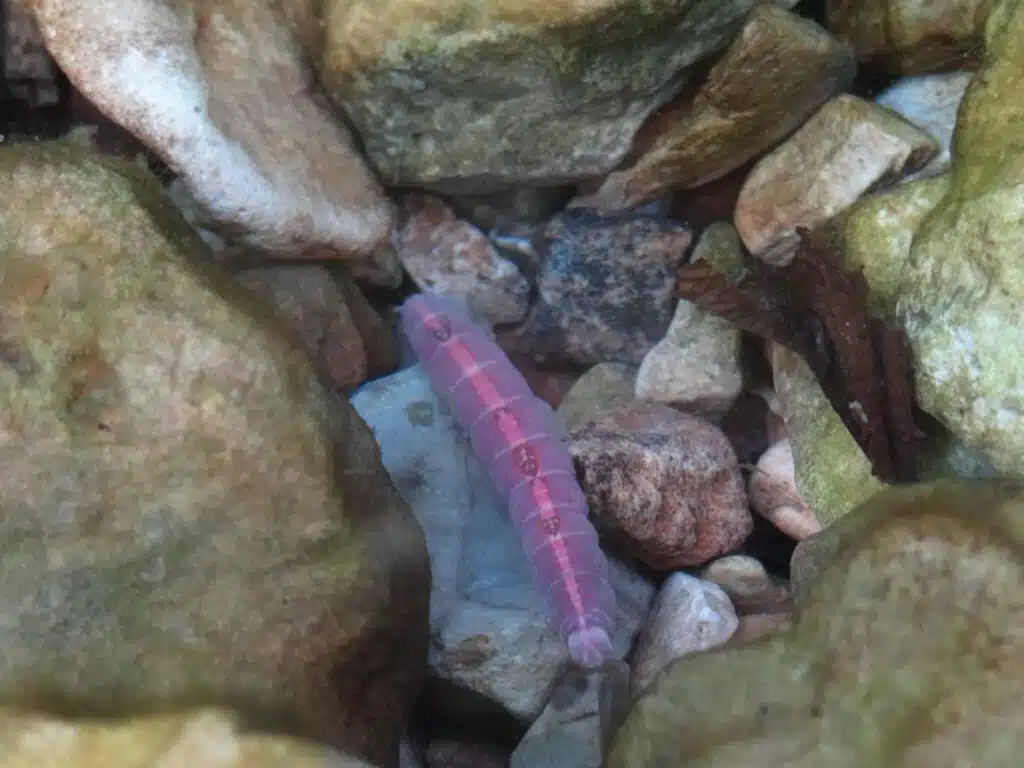
Unlike drab adults, the caterpillars of this species (Misogada unicolor) are highly colorful.
They can also be entirely purple!
Growth stages or instars come with different color changes in The Drab Prominent Caterpillar.
This is a species that goes from full purple to mostly green as it grows.
Going from pink to dark purple, this caterpillar eventually settles in a green base color with a yellow central stripe that features purple borders.
Wider in the middle, the caterpillar also shows 2 short tail-like projections.
Its feeding habits are detrimental and may even kill the host tree in case of a large-scale invasion.
At first, young Drab Prominent Caterpillars feed in groups. They live on the underside of leaves to hide from predators.
As they grow, they begin to move out and feed on their own.
Leaf skeletonization, a process in which almost the entire leaf is eaten, with the exception of its verins, is a particular feeding habit of the caterpillar.
4. Eastern White-blotched Prominent Caterpillar
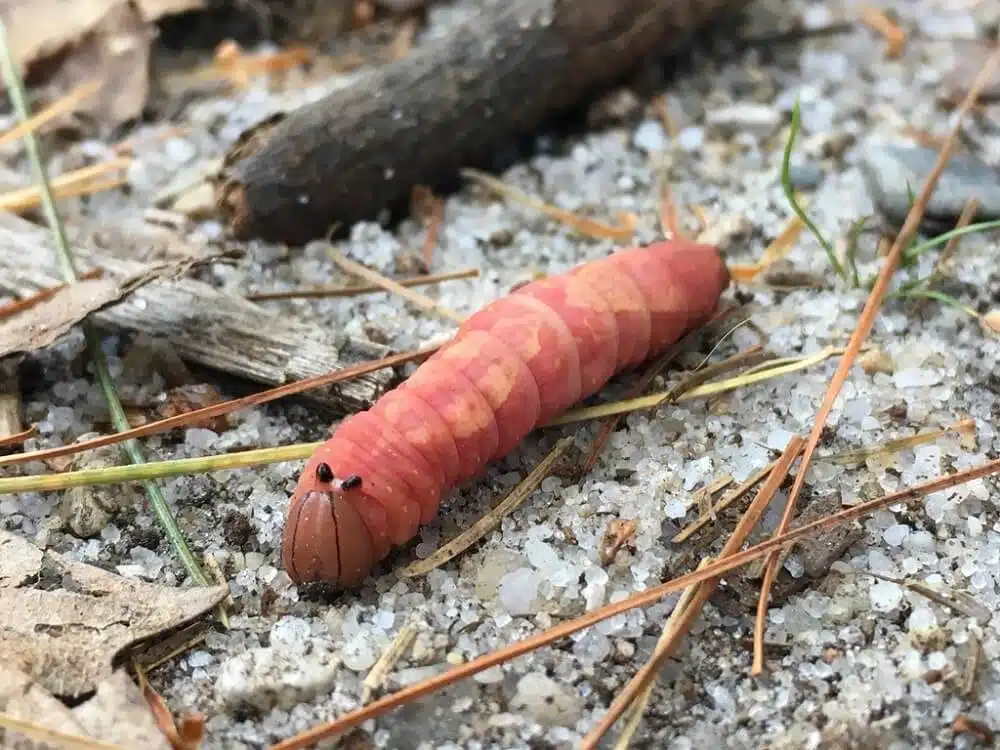
Eastern White-blotched Prominent Caterpillars (Heterocampa pulverea) are some of the most prominent purple caterpillars in North America.
This is a species that can be purple and is purple in all instars.
From pink-purple to deep purple, the nuances across its body vary from uniform to patterned.
Caterpillars of the species may show bright purple patterns or pink patterns when showcasing their purple appearance.
Purple and punk patterns are also highly common in this species.
A rare sight, the brown Eastern White-blotched Prominent Caterpillar isn’t seen for long before turning purple as well.
While feeding on broadleaf tree leaves, the impact of these caterpillars on the tree itself is small.
Eastern White-blotched Prominent Caterpillars don’t invade trees which means they aren’t pests.
They can be spotted on oak trees in oak woodlands as well as on singular oak trees in parks and gardens.
5. Ilia Underwing Caterpillar
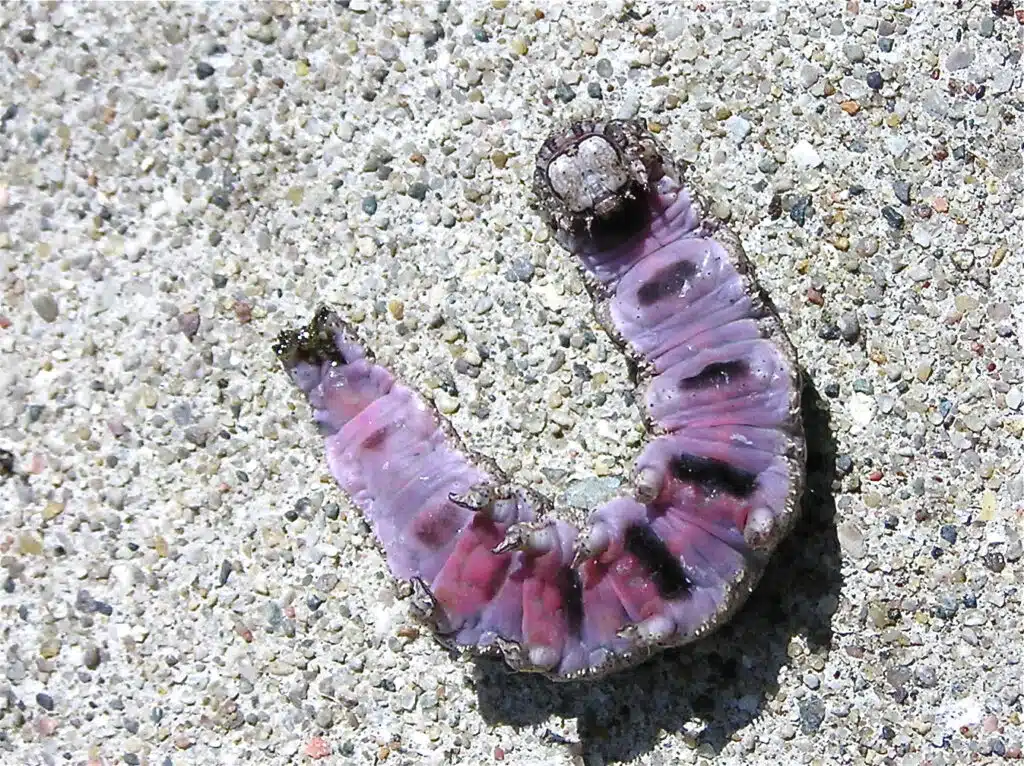
As many types of caterpillars feed on broadleaf trees, Ilia Underwing Caterpillars (Catocala ilia) are present on oak trees.
Their presence may not be easy to spot from above as they have a green color to camouflage themselves on the tree’s leaves.
However, once flipped, these caterpillars show bright purple ventral coloring.
A combination of black, purple, white, and red bands and patterns are specific to the more colorful ventral side of this caterpillar.
Its dorsal side is mostly black, with small black patterns.
When it comes to the regions preferred by these purple underside caterpillars, these are tied to various species of national and local oaks.
They are found across Southern and Southwestern US states in oak woodlands and parks.
Unlike other dull adult moths, once emerged into a moth The Ilia Underwing Caterpillar still maintains a highly contrasting appearance from the forewings to the hindwings.
Its brown, gray, and black forewings are contrasted by its black hindwings with large red eyespots.
It can be almost impossible to spot when resting on oak bark with its wings together.
6. Cucullia lilacina

Not all purple caterpillars have uniform coloring. In fact, just a small number of species are purely purple.
This is also the case of the banded Cucullia lilacina, a species with alternating, purple, pink, orange, and black bands.
Its black bands separate the colorful sections on its body, orange close to the head and purple towards the rear end.
The species is native to the Southern and Southwestern US territories as well as to Northern Mexico.
The exact range of these caterpillars expands from Arizona to West Texas.
Unlike a considerable number of purple caterpillars that feed on tree leaves and legumes, Cucillia lilacina feed on asters, types of purple wildflowers.
Some color variations may be specific to these caterpillars judging by their region. Some tend to be orange-brown and black-banded without any pink or purple colors.
Adults may also carry some purple nuances onto their forewings.
7. Indra Swallowtail Caterpillar
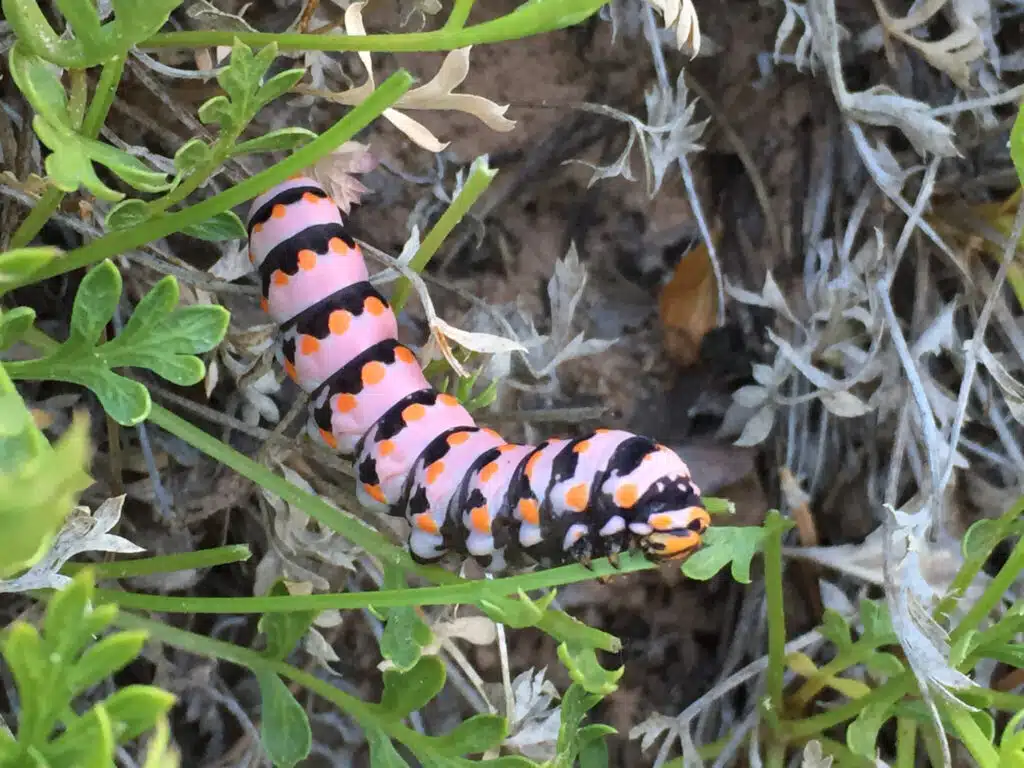
While common, The Indra Swallowtail Caterpillar (Papilio indra) may not be easy to spot due to its mountainous range.
It can also be found in canyons as well as around desert regions.
The species inhabits vast territories in Western North America and it changes colors as it grows, to eventually become a black butterfly.
In its early growth stages, The Indra Swallowtail Caterpillar isn’t all-black.
This is a species that shows black and bright purple-pink bands across the body as it goes through its initial growth phases.
Feeding on the leaves of flowers, the caterpillars may not be considered pests.
They prefer eating the small leaves of various aromatic herbs such as those of parsley.
In their final instar, these types of caterpillars are mostly black and white, although some specimens can retain the purple sections.
Once turned adults, these butterflies are found in open mountainous areas, preferably in full sun, on slopes.
Management techniques might only be required in areas such as gardens.
You can act quickly and remove the caterpillar from your parsley or aromatic herbs by hand. While it has a black appearance with short spines, these spines aren’t sharp enough to pierce human skin.
8. Poison Ivy Sawfly
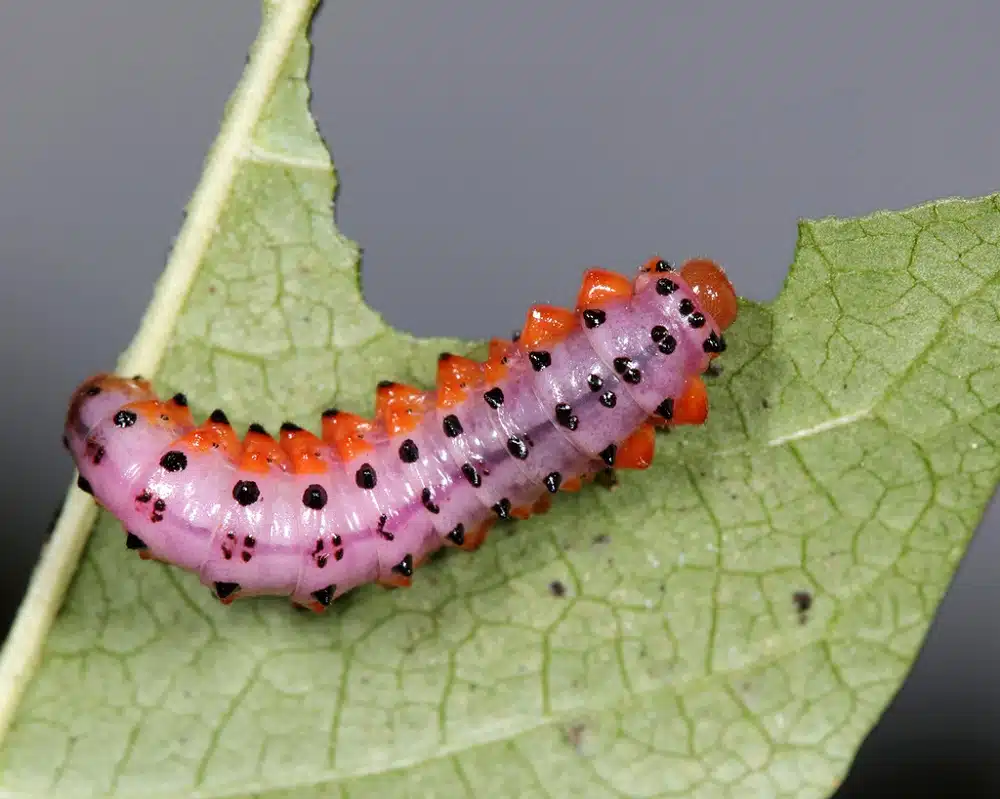
One of the atypical types of larvae that resemble caterpillars is the purple Poison Ivy Sawfly (Arge humeralis) larva.
As a caterpillar, this larva also grows and changes colors as it grows.
Initially, it holds a green color with a brown head and additional tiny black dots on the dorsum.
It doubles its size before turning salmon, pink, or even purple.
A combination of bright purple, pink, and red colors is seen across the larva in its growth stages.
The larva of these sawflies also feeds on leaves, but it prefers the toxic leaves of Poison Ivy.
Its leaves provide food for group-feeding young larvae while larger larvae tend to disperse and either fed in smaller groups or on their own.
This type of plant is known to cause allergic reactions in humans but the larvae absorb their chemicals to become bad-tasting for potential predators.